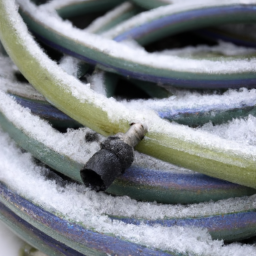How To Keep Garden Hose From Freezing
How To Keep Garden Hose From Freezing
How To Keep Your Garden Hose From Freezing
Overview
During wintertime, the last thing you need is a garden hose that's frozen solid. Perfectly chilly days can quickly turn irritating when a hose's water stream doesn't come out due to ice. Luckily, there are many ways to prevent a garden hose from freezing, some of which are rather simple and don't require expensive tools. Read on and you'll learn how to protect your garden hose from freezing and be able to use it in any season.
Tips for Keeping Your Hose From Freezing
Empty the Hose Out After Use
If you're finished using the hose for the day, disconnect it and try your best to empty the hose of water while making sure it stays upright. This prevents the water from lying stagnant in the hose and freezing, causing it to stop working the next time you use it. If you neglected to empty the hose and find that it's frozen solid, don't worry, as you can use a space heater to warm it up slowly.
Store Your Hose In a Warm Place
Make sure to store the garden hose away in a warm or at least sheltered place to avoid freezing. Cold temperatures are one of the most common reasons for a garden hose to freeze in the first place, so making sure the hose is kept away from any extreme cold will reduce the risk of this happening. If you notice any water left in your hose while you're storing it, use a shop vac to empty it out.
Insulation is Key
Wrapping your garden hose in insulation material like cotton cloth, thermal wrapping, or bubble wrap keep it from freezing in colder weather. The benefit of using insulation is that it will both reduce the risk of a moist garden hose inside freezing and prevent any water that stays inside from becoming too cold and freezing. People who live in particularly cold climates often use this kind of insulation during the whole winter season as a precaution.
Install a Faucet Sleeve
Apart from insulating the hose itself, you can also reduce the risk of your faucet freezing by fitting it with an insulating faucet sleeve. This is especially recommended when the faucet is exposed to the cold, as is often the case outdoors. To attach a faucet sleeve, all you have to do is measure the size of the faucet, choose the right sleeve for it, and then fit it onto the faucet itself. Many faucet sleeves come with many layers of both foam and bubble wrap, thus making sure your faucet won't freeze
Treat the Hose with Anti-Freeze
Using an anti-freeze is a great way to prevent water in your garden hose from freezing. All you have to do is pump a gallon or so of anti-freeze into the hose to ensure that all the water inside it is treated. We recommend a food-grade anti-freeze, as this ensures no harmful chemicals are added to the hose's water. Note that using an anti-freeze doesn't mean you should leave the hose filled with water as this could still freeze under very cold temperatures.
Keep the Faucet Running
If you live in a particularly cold climate, keeping the faucet running may be one of your best options for preventing the hose from getting frozen. While it may not be particularly effective at keeping your faucet from freezing, it's nonetheless a smart move to at least reduce the risk. Keeping the faucet running is an especially good option if you expect extreme temperatures during the winter season.
In Summary
Freezing temperatures can cause a lot of trouble to garden hoses, making them completely unusable. Fortunately, preventive measures such as these can help you avoid a garden hose getting frozen and make the most out of it in all the seasons. Remember to empty out your hose and faucet after use, store it in a warm place, and use insulation material and anti-freeze to reduce the risk of freezing. Additionally, if temperatures are expected to get really low, keeping the faucet running could help a lot too.

Previous Page